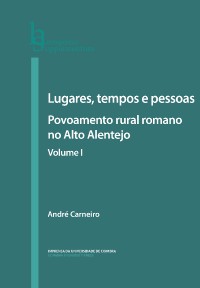Please use this identifier to cite or link to this item:
https://hdl.handle.net/10316.2/35276| Title: | Lugares, tempos e pessoas: povoamento rural romano no Alto Alentejo - vol. I | Other Titles: | Places, times and people: rural settlements in Alto Alentejo in roman times - vol. I | Authors: | Carneiro, André | Keywords: | Roman settlement;Villae;Alentejo;Roman agriculture;Povoamento romano;Villae;Alentejo;Agricultura romana | Issue Date: | 2014 | Publisher: | Imprensa da Universidade de Coimbra Annablume Editora |
Journal: | Classica Digitalia. Série Humanitas Supplementum. Estudos Monográficos | Abstract: | The aim of the present study is to offer a reading of what the distribution of the rural population of Alto Alentejo may have looked like in Roman times. Dealing with such an extensive territorial area and with such a diverse landscape has allowed us to better understand how the patterns of organisation of rural human settlements were influenced both by the natural environment as well as the pre-existing rural communities.
The period studied is intentionally long: our analysis begins with the formation of the imperial landscape and ends in 711, a milestone which is considered significant in establishing the boundary with the Ancient World.
Drawing on substantial work of archaeological prospection, this study therefore proceeds to analyse the factors that motivated the creation of a landscape that was inhabited and modified throughout Empire and Late Antiquity by many diverse people. O propósito do presente estudo centra-se na leitura do que terá sido a rede de povoamento rural em época romana na região do Alto Alentejo. Uma área territorial extensa e com uma paisagem muito diversa, o que permite tentar perceber como se alteram os padrões de organização de sítios, em função desse quadro natural, mas também das comunidades que já habitavam este território. Também o tempo escolhido é intencionalmente longo, pois na análise considera-se a evolução desde o estabelecimento da paisagem imperial até à data de 711, marco temporal que de alguma forma se assume como significante para estabelecer a fronteira com o mundo antigo. Assim, com uma forte componente de trabalho de prospecção, procede-se a uma análise dos factores que motivaram a criação de uma paisagem onde, durante o Império e a Antiguidade Tardia, as mais diversas pessoas habitaram e modificaram o território que é hoje o Alto Alentejo. |
URI: | https://hdl.handle.net/10316.2/35276 | ISBN: | 978-989-26-0832-7 (PDF) | DOI: | 10.14195/978-989-26-0832-7 | Rights: | open access |
| Appears in Collections: | Pombalina |
Files in This Item:
| File | Description | Size | Format | |
|---|---|---|---|---|
| povoamento_rural_vol_i.pdf | 87.12 MB | Adobe PDF |  |
Items in DSpace are protected by copyright, with all rights reserved, unless otherwise indicated.
